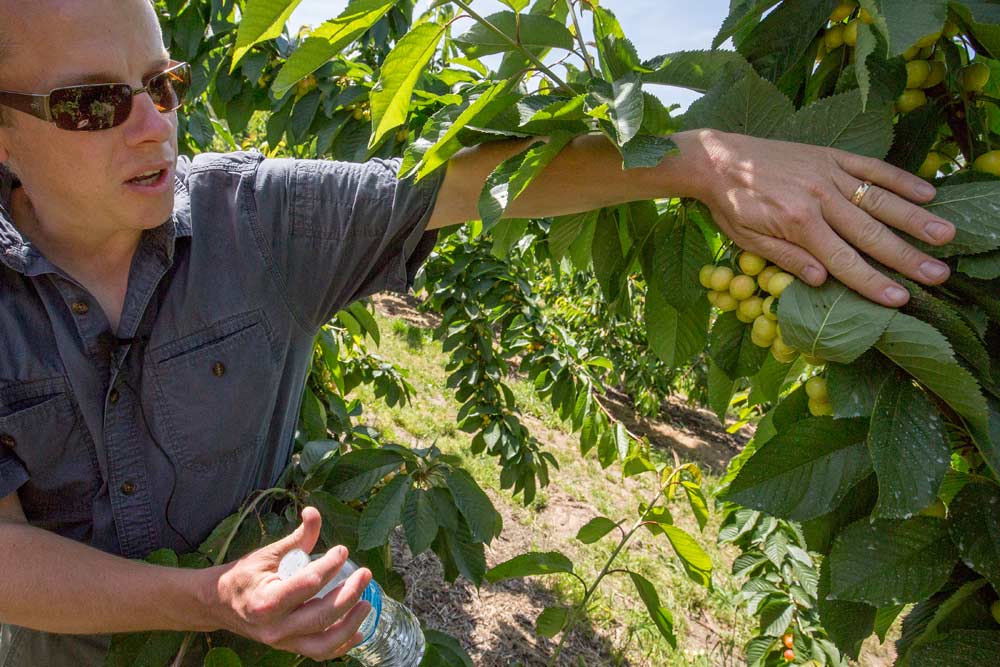
Mike Omeg shows how some of his cherry trees had rebounded by summer 2016 after receiving soil amendments, boosting root growth and improving overall tree health. (TJ Mullinax/Good Fruit Grower)
The Omeg family had farmed one, 17-acre block of cherries — Bings on Mazzard rootstock — for more than 40 years, but in 2006, Mike Omeg decided the orchard needed to be updated.
In addition to keeping some of the original Bing trees, he planted three different varieties — Regina on Gisela 12, Sweetheart on Mazzard, and Skeena on both Mazzard and Gisela 12. The Skeena always showed good performance, but he reevaluated the other two varieties five years later to see what renewal could be done to improve performance there.
Regina on Gisela 12
In particular, Omeg found that the Regina on Gisela 12 suffered from bacterial canker, resulting in a decline in the overall health of the tree, negatively affecting the crop.
“We had very few cherries, they were small, and we were losing a lot of trees,” he said. “And when you lose too many trees in a block, it doesn’t become economical to farm that block anymore, because your overhead for a blank space is essentially the same as if a tree was there. Because you’re still driving past it when you water, when you mow, when you spray. The only thing you save on is that you don’t have to prune it because it’s dead.”
Omeg suspected there was an herbicide residue in the soil that was preventing root hairs from developing; digging up roots showed inadequate root development.
He applied a microbial mix and biostimulant to the soil and started seeing root growth within a couple of weeks, followed by shoot growth, which he hadn’t seen in years in that orchard.
Omeg’s effort to stimulate microbes in the soil involves adding organic matter — either compost and mulch in bulk compost applications to the surface of the soil or through mow and blow treatments.
He also uses a blend of both microproducts and nutrients: primarily microbes for soil bacteria and fungi and micronutrients to stimulate microbial growth, including molasses, humates and fish.
Sweethearts
The Sweetheart trees in the block have always struggled; they didn’t have a very large canopy, so they always suffered from poor fruit quality. The site is windy, and with a small canopy increasing heat exposure and a late harvest date, the fruit were exposed to the greatest environmental stresses of any variety on the farm.
By applying the soil restoration, along with intensive foliar nutrition, Omeg has dramatically improved the leaf coverage. “Now when you look at these trees, you see mostly cherries, but you have to actually lift the leaves up to see if there’s fruit under there. We like that,” he said.
In addition to improved leaf coverage along fruit-bearing branches, the trees also have nice shoot extension.
Omeg also said it’s hard to find powdery mildew in the block, even though Sweetheart is particularly susceptible.
“Everything that we do to grow a big, thick and lush canopy, to protect those cherries from the wind and from the heat, also encourages mildew, and yet we’re able to grow this big canopy and we have no mildew problems here at all,” he said.
Omeg even stepped back his fungicide program on the Sweethearts after seeing a reduction in powdery mildew in the Regina block, because he wanted to see how a more susceptible variety would do.
“So far, we haven’t seen problems, and if we continue to see this over the next couple of years, it would be a tremendous benefit for us to cut down on our fungicide sprays.”
Looking ahead

These cherry trees at Omeg Orchards in The Dalles, Oregon, struggled for several years after planting, but Mike Omeg helped them rebound by providing soil amendments that improved root growth and overall tree health. The cherry varieties in this block are a mix of Regina, Skeena and Sweetheart, as well as some Bing he kept from the original planting. (TJ Mullinax/Good Fruit Grower)
After four years of application, Omeg said last spring that quite a few trees in the block looked good.
Some still had a way to go, but he didn’t believe then that he would have to pull the orchard block — representing a huge savings.
“I’m skeptical by nature, so I have to see something myself, I have to have it demonstrated to me to believe that it’s applicable on my operation,” he said. “We started working here, and I started seeing a turnaround in these trees — quickly, which was really surprising to me.”
He changed his mind this spring, he said recently, but not because of the quality of the trees, which have recuperated quite nicely. “It’s too much of a patchwork of small, inefficient blocks, of varieties that are not appropriate to that site and timing,” he said.
Four different varieties are planted in a 17-acre block, which just isn’t efficient for harvest, he said. “In hindsight, I probably should have invested those resources in another block. But I took my worst performing block and I turned it into a moderate performer.”
And what’s he’s learned certainly isn’t lost, he said, adding, “I’ve already been applying it in other blocks and seen results.” •
– by Shannon Dininny






Leave A Comment